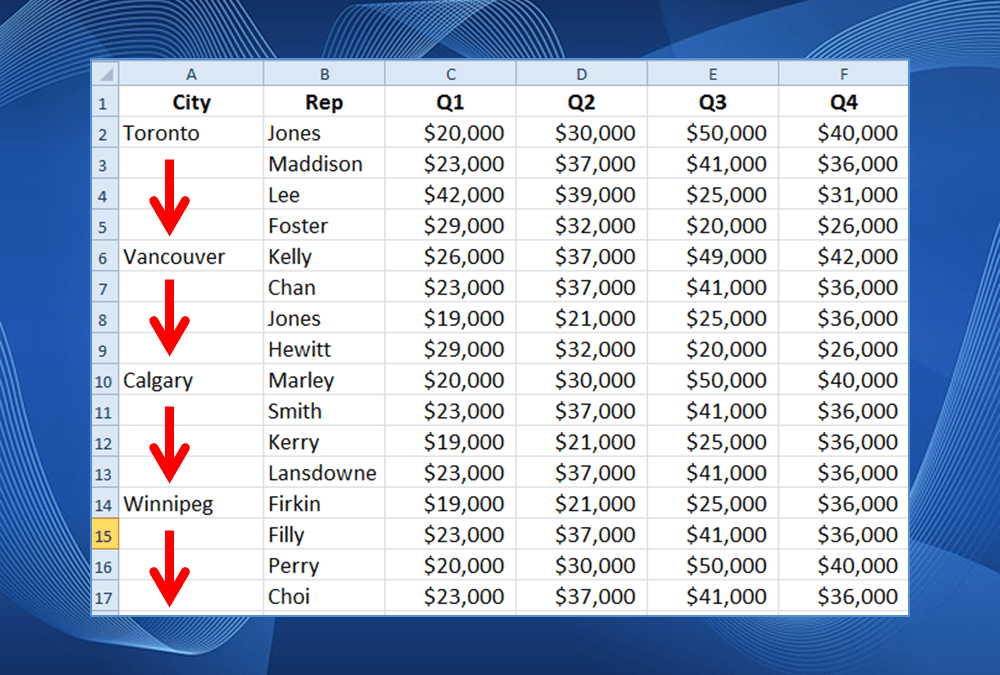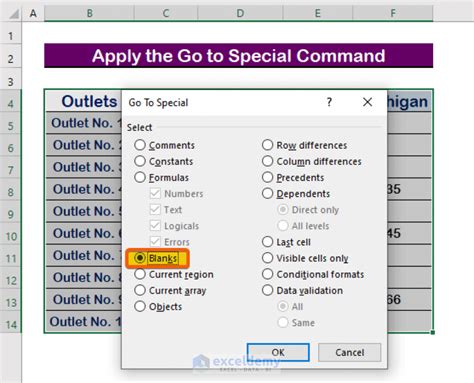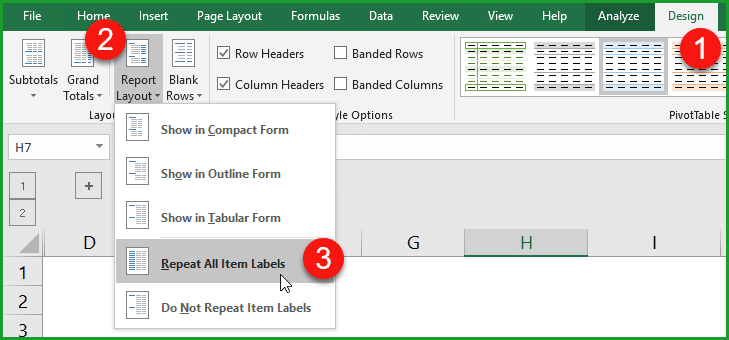Excel Tip: Fill Blanks Fast!

Are you tired of manually filling in those pesky blank cells in your Excel spreadsheets? Do you find yourself spending precious time and energy on tedious tasks that could be automated? Well, look no further! In this comprehensive guide, we will unveil a powerful Excel tip that will revolutionize the way you handle blank cells. Get ready to boost your productivity and efficiency as we dive into the world of "Excel Tip: Fill Blanks Fast!"
Automating Blank Cell Fill with Excel’s Power Tools

Excel, the versatile spreadsheet giant, offers a range of powerful tools to streamline your data management. Among its many features, we will explore the art of quickly filling blank cells, ensuring your spreadsheets are neat, organized, and ready for analysis.
Imagine having the ability to transform scattered, incomplete data into a well-structured dataset with a few simple clicks. With Excel's advanced functions and techniques, this dream becomes a reality. By harnessing the power of formulas, functions, and Excel's intuitive interface, you can save hours of manual work and focus on the insights your data holds.
The Magic of Excel’s Fill Handle
One of the most valuable tools in Excel’s arsenal is the Fill Handle. This little icon, located in the bottom-right corner of a selected cell, is your gateway to quick and efficient data filling. By simply clicking and dragging the Fill Handle, you can propagate data across rows or columns, instantly filling in blank cells with the desired pattern.
For instance, consider a simple scenario where you have a list of employee names, but some cells are left blank. With the Fill Handle, you can quickly fill in those blanks with the name from the previous cell, ensuring a consistent and complete dataset. This simple technique saves you from the tedious task of manually typing each name, enhancing your efficiency tenfold.
Unleashing the Power of Formulas and Functions
While the Fill Handle is a powerful tool, Excel’s true magic lies in its extensive collection of formulas and functions. These built-in tools allow you to perform complex calculations, manipulate data, and automate repetitive tasks with ease.
Let's explore a real-world example. Imagine you have a list of sales figures, but some cells are missing data due to holidays or other factors. Instead of manually entering the missing values, you can utilize Excel's IF function. By creating a formula that checks for blank cells and provides an appropriate value, you can automatically fill in the gaps. For instance, you might set the formula to replace blank cells with the average of the surrounding values, ensuring a consistent and reliable dataset.
Additionally, Excel's VLOOKUP function can be a game-changer when dealing with large datasets. This function allows you to search for specific values in a table and retrieve corresponding data. By combining VLOOKUP with conditional formatting, you can highlight blank cells that need attention, making it easier to fill them accurately.
| Formula | Description |
|---|---|
| IF | Checks for a condition and returns one value if the condition is TRUE and another value if the condition is FALSE. |
| VLOOKUP | Searches for a value in the leftmost column of a table and returns a value in the same row from a specified column. |

Advanced Techniques for Complex Scenarios
For more intricate data structures, Excel offers advanced techniques to handle blank cells effectively. One such technique is the use of Array Formulas. These formulas allow you to perform calculations on multiple cells simultaneously, making them ideal for filling in blank cells with complex calculations.
Another powerful tool is the Text to Columns feature. This function enables you to split data into separate columns based on delimiters, such as spaces, commas, or tabs. By utilizing this feature, you can easily separate and reorganize data, ensuring that blank cells are filled with the appropriate values.
Best Practices and Tips for Efficient Blank Cell Handling

While Excel provides an array of tools to fill blank cells, there are best practices and tips to ensure optimal efficiency and accuracy.
-
Data Validation: Before filling in blank cells, ensure the data you are working with is clean and consistent. Use Excel's Data Validation feature to set rules and restrictions, preventing inaccurate or inconsistent data from being entered.
-
Consistency is Key: Maintain a consistent data structure throughout your spreadsheet. This makes it easier to identify and fill in blank cells, as patterns and trends become more apparent.
-
Utilize Conditional Formatting: Conditional formatting is a powerful tool to highlight blank cells or cells with specific criteria. By applying visual cues, you can quickly identify areas that need attention and focus your efforts efficiently.
-
Save Time with Keyboard Shortcuts: Excel offers a plethora of keyboard shortcuts to streamline your workflow. Familiarize yourself with shortcuts for filling cells, copying formulas, and navigating your spreadsheet. These shortcuts can save valuable time and enhance your overall productivity.
Real-World Application: Case Study
Let’s explore a real-world scenario to see how these techniques can be applied. Imagine you are an accountant tasked with managing financial data for a small business. The business has provided you with a spreadsheet containing monthly sales figures, but due to various reasons, some cells are left blank.
By utilizing Excel's Fill Handle, you can quickly propagate the sales figures across rows, ensuring a complete dataset. For blank cells that represent weekends or holidays, you can employ the IF function to replace them with a value indicating "No Sales." This not only fills in the blanks but also provides valuable insights into the business's sales patterns.
Furthermore, by applying conditional formatting, you can highlight cells with sales figures above a certain threshold, allowing you to quickly identify top-performing months. With Excel's powerful tools, you can efficiently analyze and interpret the data, providing valuable insights to the business owners.
Conclusion: Empowering Your Excel Journey
Excel’s ability to quickly fill blank cells is a powerful tool that can transform your data management and analysis process. By mastering the Fill Handle, formulas, functions, and advanced techniques, you can save time, improve accuracy, and gain deeper insights from your data.
As you embark on your Excel journey, remember that practice makes perfect. Experiment with different techniques, explore Excel's extensive features, and always seek to optimize your workflow. With the knowledge and skills gained from this guide, you'll be able to tackle any blank cell challenge that comes your way, empowering you to make informed decisions and drive success in your endeavors.
How can I quickly fill in a series of blank cells with the same value?
+To fill a series of blank cells with the same value, you can use Excel’s Fill Handle. Simply select the first blank cell, enter the desired value, and then click and drag the Fill Handle down or across to fill in the remaining blank cells with the same value.
What if I need to fill blank cells with a pattern or sequence?
+Excel’s Fill Handle is capable of recognizing patterns and sequences. If you have a series of cells with a consistent pattern, such as 1, 2, 3, 4, and you need to fill in the next few cells, simply select the cells with the pattern, click and drag the Fill Handle, and Excel will continue the sequence for you.
Can I fill blank cells with data from another cell or range of cells?
+Absolutely! Excel provides various methods to achieve this. One way is by using the Fill Handle and selecting the cells you want to fill. Then, click and drag the Fill Handle while holding down the Ctrl key. This will copy the data from the selected cells into the blank cells.
Are there any shortcuts to quickly fill in blank cells with specific formulas or functions?
+Yes, Excel offers keyboard shortcuts to speed up the process. For example, you can use the shortcut Ctrl + D to fill down the formula or value from the cell above into the blank cells below. Similarly, Ctrl + R will fill the formula or value from the cell to the left into the blank cells to the right.



